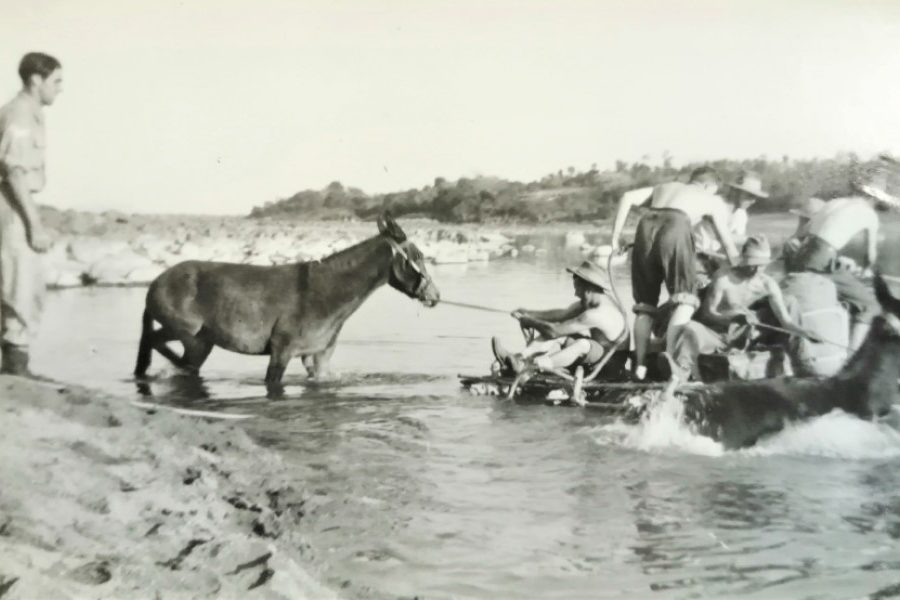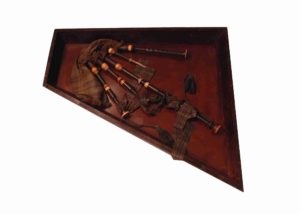Major-General David Stewart of Garth
Just before heading up the stairs to Gallery 4 visitors will see the painting of someone who, on first glance, might not look like a
Home » Blog » Black Watch History » Victory in Japan – The End of World War Two



Although 8th May 1945 marked the end of hostilities in Europe, the conflict in the Far East was not over. Thousands of Allied Forces continued to fight in Asia and the Pacific, while many languished in Japanese Prisoner of War camps.
This included soldiers from the 2nd Battalion, The Black Watch who had been in Burma since March 1944. The Japanese invasion of Burma in 1941 posed a deadly threat to the British India where the 2nd Battalion arrived just as new tactics were being developed. In late 1943, the Battalion became part of the Chindits, men trained in jungle warfare, operating behind enemy lines and attacking Japanese supply routes.
Now deep into Burma, the men relied on aircraft to replenish their limited supplies and spent the next few months attacking Japanese forces in order to divert them from the frontline. In this intensely humid jungle setting, the soldiers lived off American K rations, which came in waxed paper, itself useful for starting fires in the wet jungle. Although highly calorific, if these rations were not supplemented with ordinary food the men suffered from diarrhoea and dysentery, which needed to be hidden underground in order to protect their position. This was also the case with cigarette butts which they pressed into the ground vertically to hide them.
Private Cochrane recounted that ‘all the mules had their vocal cords cut…so that they couldn’t make any noise, it was a terrible thing to do to the animals, but what was the alternative?’
Approximately 800 Black Watch soldiers went into the jungle in March 1944. When they were withdrawn, only 5 months later in August 1944, only two officers and 48 men were judged fit for duty. Many of the men were only able to eat soup, their stomachs having shrunk to such an extreme. Cochrane recalled that on arrival in Assam, their recuperation began with ‘blanket’ treatment ‘to acclimatise us back to eating usual rations, so we were given lots of chicken soup’.
Following the withdrawal of the Battalion that August, they were reinforced and were scheduled to take part in the planned invasion of Malaya in 1945. The dropping of the atomic bombs on Hiroshima and Nagasaki on the 6th and 9th August respectively, following an ignored ultimatum from the Allied forces demanding Japan’s unconditional surrender on 26th July, brought the war to a sudden end. On the 15th August 1945, US President Harry S. Truman announced that the Japanese Government had agreed to surrender and calling it ‘Victory over Japan Day’. A two-day holiday was announced in the US, the UK and Australia and King George VI addressed the nation and the Empire from Buckingham Palace.
The Battalion war diary describes how the men celebrated:
15th August
‘Victory Day. To celebrate victory Wednesday and Thursday were announced as holidays. The Battalion celebrated by having a fun fair with elephant rides and pony racing and all sorts of side shows. Every man in the Battalion was issued with three bottles of beer. One half of the Battalion spent the evening at the Battalion concert which proved a great success while the other half held a sing-song.’
16th August
‘Battalion still celebrating, everyone in high spirits. Another issue of two bottles of beer per man.’
Throughout the world, celebrations marked the end of 6 years of conflict, and as on VE Day there were street parties, bonfires and fireworks. Following the signing of the peace treaty by the Japanese administration on 2nd September, the Allied forces stationed in western Europe paraded through Berlin. For the men still in Asia the wait was now on to get home.
Private Graves wrote, ‘… we settled down to our duties and in the afternoons education classes were started. Every day now the chaps who had been abroad a few years were going home and with the war over some were now on demobilisation… At the time of writing now we are getting into peace time routine every day. Plenty of spit, polish, drill parades and ceremonial guards.’
The end of the war in the Far East is often overshadowed by the surrender of Nazi Germany in May of that year. The memories and experiences of those soldiers who served there have not been forgotten and we continue to remember their sacrifices today.
Just before heading up the stairs to Gallery 4 visitors will see the painting of someone who, on first glance, might not look like a

Rosie Waine is the William Grant Foundation Research Fellow at the National Museum of Scotland. Here she writes how the Black Watch Museum & Castle
The Black Watch Museum archive holds a considerable quantity of primary source material relating to the Battle of Loos, 24th September 1915. This event has
Subscribe to Our Newsletter
© The Black Watch Castle and Museum
The Black Watch Regimental Trust is a charitable company registered in Scotland | Charity No: SC005848

14 thoughts on “Victory in Japan – The End of World War Two”
My uncle John was in Burma with the Black Watch. He never spoke about his time there. He was a very nice man but the family said ” the war was a traumatic experience for him”
When I was a young boy, he would teach me bush craft.
I will forever have fond memories of him.
Thank you for sharing this with us.
Our Father was a Chindit and joined the Black Watch in 1944 a wonder he survived but he did .
Greatest respect to all.
Thanks for sharing this. Sadly, my great uncle Samuel Christie Annal was one of those men of the Black Watch who didn’t make it to VJ Day, dying in the Myanmar jungle in 1944.
I wrote about him to mark this year’s Remembrance Day:
https://lifelinesresearch.co.uk/2022/11/10/remembered-always/
Do your archives hold anything on my father Francis Edward McColgan from Glasgow b.Feb.1926?
He did not feature much in my life after I was 11 and died in 1986.
I know he was promoted to Captain in the Field at the age of 18 1/2, was “out in India” in 1944/45 in the Black Watch Commandos and trained for the airborne assault to re-take Singapore which never happened because of the atomic bombs on Hiroshima and Nagasaki. The fact that he was trained for battle readiness and presumably ready to die but possibly not mentally de-sensitised and stood down after the attack was called off cast a long shadow over his life I have long believed.
Hello Stephen,
Thank you for getting in touch.
As we do not have the resources to participate in unfunded research we ask for a £10 non-refundable donation. Please look at our Trace a Soldier page for details on where to look for information before submitting a form with us. Soldier records after 1920 are held at the Army Personnel Centre and we have very limited information on individual soldiers from this time onwards.
If you would like to proceed please submit a research request please visit wwww.theblackwatch.co.uk/research. You will then be routed to a page to make payment.
After we have received your completed research enquiry form and your payment a member of our research team will be in touch to discuss your enquiry. We will do our best to answer your enquiry but cannot guarantee that we will be able to do so.
Best wishes,
The Museum and Archive Team
Hi Stephen, it sounds like my dad was with yours in India.
My dad was also training to re-take Singapore, luckily it never did happen, we have a picture of him in his uniform with the airborne badge on. He was a private in the Black Watch, 2nd Btn he was actually de-mobbed from India in 1947
Re the note from Mr McColgan
From the info regarding his late father it looks like my father was in India with BW 2nd Btn at approx same time.
I visited National archive at Kew approx 18 months ago and reviewed Black Watch records in India for 1944/45 . I have “photos “ of several pages of the war record which I can send you if Mr McColgan is interested. If they have the army number for the father things like promotions are all
Listed . I found details of my late father who was a Private twice. I was then able to get the actual company and from the war record you can figure out what each company was doing
Hope this is of help
Hi James, my dad was in the 2nd Btn and was in Karachi India he was a private. His name was George Sellars and his Army number was 14278192. I believe he was training for Japan. He didn’t speak much of his time in the army I wasn’t sure if I coud get a copy of his service records with the black watch, I would like to find out what I can about his time in the army.
Any suggestions greatly appreciated as to how to go about this.
My Uncle Douglas Sidney Chalmers was in the second Black Watch firstly in Abyssinia in 1943/44 .He then went to Burma in 1944 to join the Chindits with the second Black Watch. I have tried to find out his military history on several heritage sites but cannot find out any information whatsoever. His original regiment was the Beds and Herts ,he was with these at Tobruk .For some reason he was transferred to the BW after Tobruk.
My grandfather trained with Argyll’s, although he never talked about much to do with war, he did tell me about winning £500 in a hand of poker while on a train travelling through occupied France, which I think put him on the road to Tobruk. I believe his regiment was on a ferry that sank with only a few survivors, he was then amalgamated into 2nd Black Watch etc etc, quite often I think this is how things went
My late father was in the 2nd Btn Black Watch he joined in 1942 and de-mobbed in 1947
He did his training at Berwick upon Tweed
I know he was in Karachi, India as I have photos but other than that I don’t know where else he was.
I am trying to find out as much information for our family as I possibly can and would much appreciate any guidance.
Hello Gillian,
Thank you so much for sharing information about your father, George Sellars, and his service in the 2nd Battalion in Karachi, India. We appreciate your interest in learning more about his time in the army and his training for Japan.
To assist you in obtaining his service records with The Black Watch, we recommend reaching out to our research department. Please feel free to email them at research@theblackwatch.co.uk with any details or inquiries you may have regarding your father’s service. They will do their best to provide you with the information you are seeking.
Once again, thank you for reaching out and sharing your family’s connection to The Black Watch. We hope you find the information you are looking for.
Hi Catriona,
Thank you very much for replying, apologies for not seeing this sooner.
Thank you for the information I will e-mail the research team and see if they can provide me with more details.
Regards
Gillian